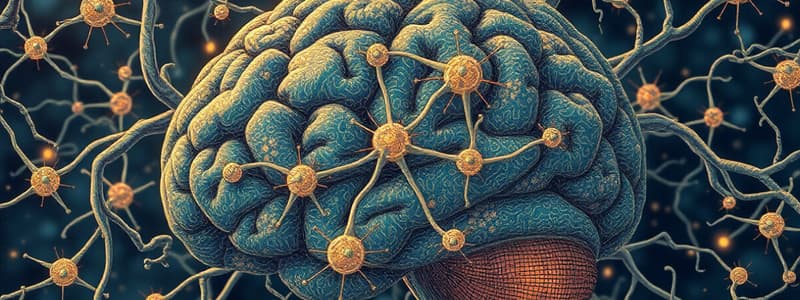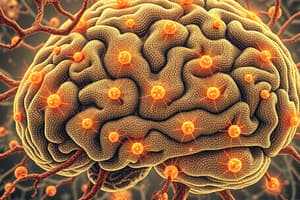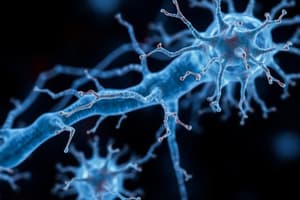Podcast
Questions and Answers
What is the primary function of a neuron?
What is the primary function of a neuron?
- To transmit information throughout the body (correct)
- To digest food and absorb nutrients
- To protect the body from pathogens
- To produce energy for the body
Which neuronal structure is most like an 'antenna' receiving signals from other neurons?
Which neuronal structure is most like an 'antenna' receiving signals from other neurons?
- Dendrite (correct)
- Axon
- Terminal button
- Soma
The 'synapse' can be best described as:
The 'synapse' can be best described as:
- The insulating layer around the axon
- The main body of the neuron
- The structure that produces neurotransmitters
- The gap between two communicating neurons (correct)
What is the electrochemical message that travels along the axon of a neuron called?
What is the electrochemical message that travels along the axon of a neuron called?
The myelin sheath's primary function is analogous to the insulation around:
The myelin sheath's primary function is analogous to the insulation around:
Which type of neuron is likely to have the longest axon?
Which type of neuron is likely to have the longest axon?
What is the function of 'axoplasmic transport' in a neuron?
What is the function of 'axoplasmic transport' in a neuron?
What is the direction of 'anterograde' axoplasmic transport?
What is the direction of 'anterograde' axoplasmic transport?
Terminal buttons are primarily responsible for:
Terminal buttons are primarily responsible for:
Neurotransmitters released into the synapse can have which of the following effects on a postsynaptic neuron?
Neurotransmitters released into the synapse can have which of the following effects on a postsynaptic neuron?
The 'soma' of a neuron is another name for its:
The 'soma' of a neuron is another name for its:
What is a key component of the cell membrane of a neuron?
What is a key component of the cell membrane of a neuron?
Microtubules are components of the cytoskeleton and also play a direct role in:
Microtubules are components of the cytoskeleton and also play a direct role in:
What is the primary energy source for a neuron, produced by mitochondria?
What is the primary energy source for a neuron, produced by mitochondria?
The nucleus of a neuron contains chromosomes, which are crucial for:
The nucleus of a neuron contains chromosomes, which are crucial for:
If retrograde transport is disrupted in a neuron, what would be the most immediate consequence?
If retrograde transport is disrupted in a neuron, what would be the most immediate consequence?
Considering the function of the cytoskeleton, damage to it would MOST directly affect a neuron's:
Considering the function of the cytoskeleton, damage to it would MOST directly affect a neuron's:
Imagine a drug that selectively blocks voltage-gated sodium channels along the axon. What neuronal process would be MOST directly inhibited?
Imagine a drug that selectively blocks voltage-gated sodium channels along the axon. What neuronal process would be MOST directly inhibited?
A disease damages the myelin sheath of neurons in the central nervous system. Which of the following symptoms would be the MOST likely direct consequence?
A disease damages the myelin sheath of neurons in the central nervous system. Which of the following symptoms would be the MOST likely direct consequence?
If a neuron were unable to produce vesicles, which of the following processes would be MOST immediately compromised?
If a neuron were unable to produce vesicles, which of the following processes would be MOST immediately compromised?
Flashcards
Dendrite
Dendrite
Receives messages from other neurons, acting like an antenna with a tree-branch-like structure.
Presynaptic Cell
Presynaptic Cell
A neuron that sends a message to another neuron.
Postsynaptic Cell
Postsynaptic Cell
A neuron that receives a message from another neuron.
Synapse
Synapse
Signup and view all the flashcards
Axon
Axon
Signup and view all the flashcards
Myelin Sheath
Myelin Sheath
Signup and view all the flashcards
Action Potential
Action Potential
Signup and view all the flashcards
Axoplasmic Transport
Axoplasmic Transport
Signup and view all the flashcards
Anterograde Transport
Anterograde Transport
Signup and view all the flashcards
Retrograde Transport
Retrograde Transport
Signup and view all the flashcards
Terminal Buttons
Terminal Buttons
Signup and view all the flashcards
Neurotransmitter
Neurotransmitter
Signup and view all the flashcards
Soma
Soma
Signup and view all the flashcards
Membrane
Membrane
Signup and view all the flashcards
Cytoskeleton
Cytoskeleton
Signup and view all the flashcards
Cytoplasm
Cytoplasm
Signup and view all the flashcards
Mitochondria
Mitochondria
Signup and view all the flashcards
Nucleus
Nucleus
Signup and view all the flashcards
Study Notes
- Neurons, also known as brain or nerve cells, transmit information to facilitate behavior.
Key Neuronal Structures
- Dendrites: Act as the neuron's receiver, similar to an antenna.
- Axon: Along with terminal buttons, aids in sending messages.
- Terminal Buttons: Important for sending neuronal messages.
- Soma: The neuron's cell body.
Dendrites
- They receive chemical messages from other neurons.
- Function like tree branches to receive messages.
Communication Between Neurons
- Presynaptic Cell: Sends messages (colored in purple).
- Postsynaptic Cell: Receives messages (colored in green).
- Synapse: Gap between two neurons where messages are sent.
- The synapse is formed between the terminal buttons of the presynaptic neuron and the dendrites of the postsynaptic neuron.
Axon and Action Potential
- Axons are message senders, resembling long tubes.
- They transmit electrochemical messages, known as action potentials, along their surface.
- Action potentials travel from the cell body to the terminal buttons.
Myelin Sheath
- It is an insulation around the axon
- Prevents electrical messages from spreading or interfering with other neurons.
Axon Length
- Axon length varies depending on function.
- Sensory and motor neurons have long axons for distant travel.
- Interneurons in the central nervous system have much shorter axons.
- Besides transporting action potentials, axons transport substances; neuron-needed substances might be produced in the cell body or terminal buttons.
Axoplasmic Transport
- Axons transport substances between the soma and terminal buttons through axoplasmic transport, happening inside the axon.
- Microtubules: Protein strands act like train tracks for substance transport in vesicles.
- Anterograde Transport: Substances travel from soma to the terminal button, its faster than retrograde transport.
- Retrograde Transport: Substances travel from the terminal button back to the soma.
Terminal Buttons
- Terminal buttons secrete chemicals called neurotransmitters into the synapse for neuronal communication.
- Neurotransmitters released by the presynaptic cell are detected by the dendrites of the postsynaptic cell.
- Neurotransmitters can have excitatory or inhibitory effects on the receiving cell, influencing the likelihood of an action potential.
Soma
- The soma is the cell body of the neuron, containing the cell nucleus and other machinery for neuronal function.
- Soma shape varies depending on neuron type and function.
- The membrane, a lipid layer with proteins, outlines the cell body which is critical for cell communication.
- Membranes contain proteins that act as substance detectors, security guards, and transporters.
Cytoskeleton
- Made of linked protein strands, providing shape and structure, as well as structural support for the neuron.
- Includes microtubules for substance transport.
- Cytoplasm: Jelly-like substance inside the membrane containing organelles like the nucleus and mitochondria.
- Mitochondria: Produces adenosine triphosphate (ATP), the energy source for the cell.
- Nucleus: Contains chromosomes with genetic information for producing proteins.
- Proteins act as enzymes, controlling chemical reactions within the cell.
Studying That Suits You
Use AI to generate personalized quizzes and flashcards to suit your learning preferences.




